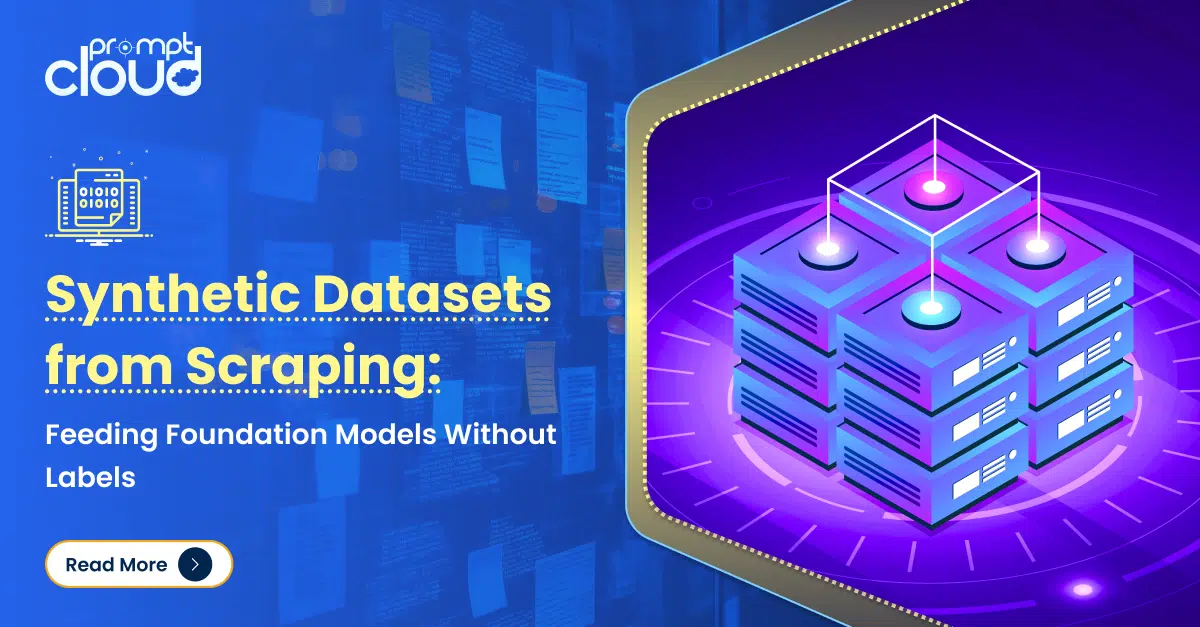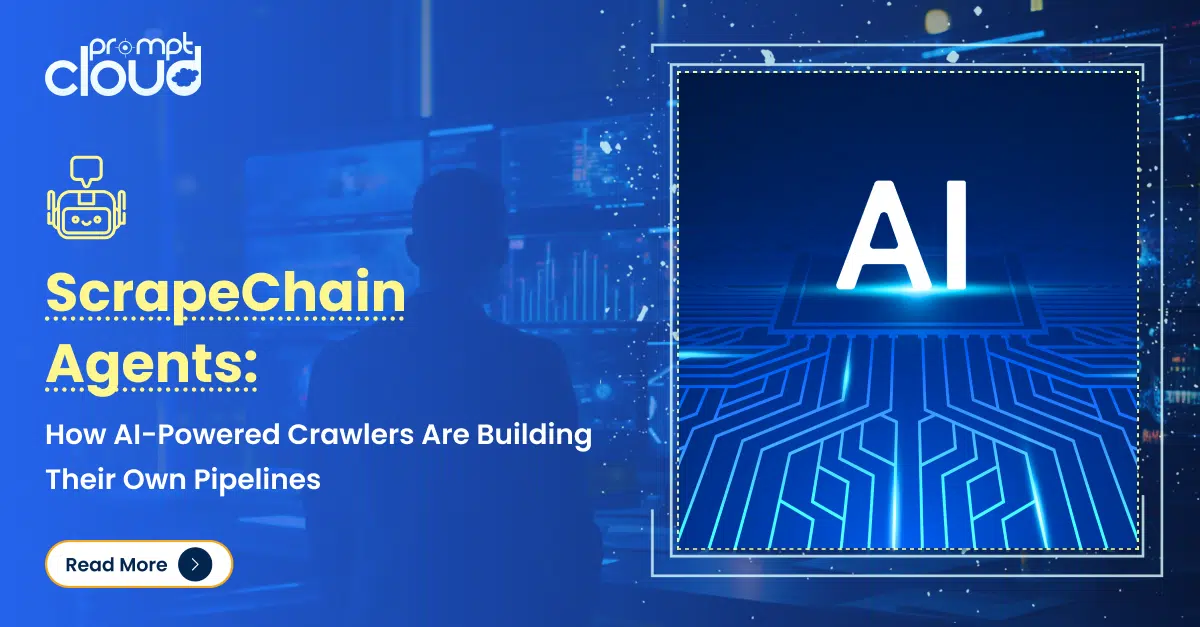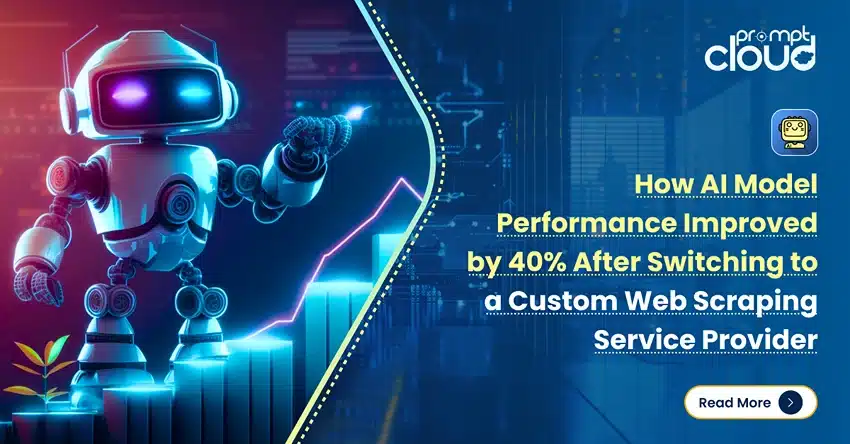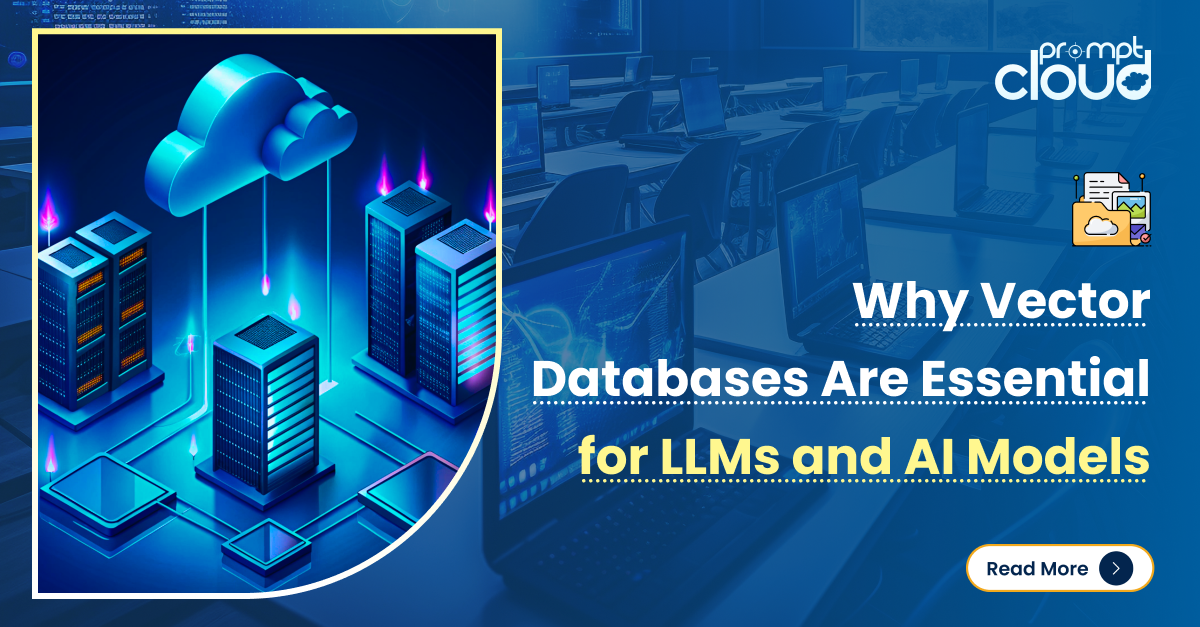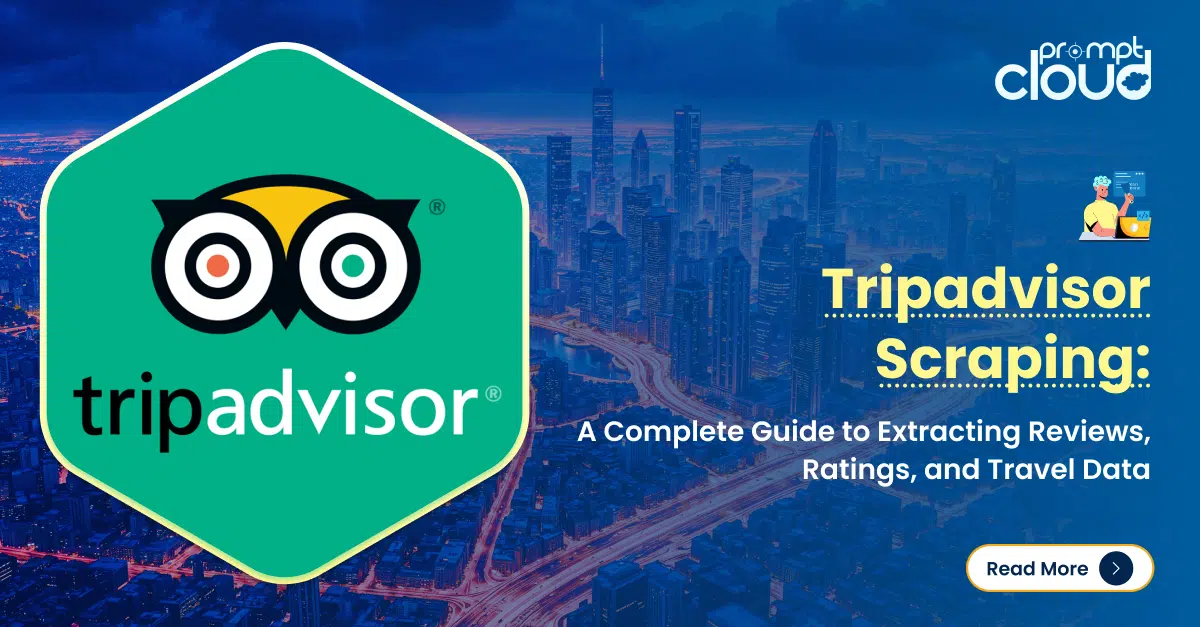
You’ve probably used Glassdoor.com before to check salary benchmarks, peek at competitor reviews, or maybe just see what people are saying about your own company. But here’s the thing: most people only scratch the surface.
What many companies are doing now is scraping Glassdoor, pulling large volumes of public data from the site, to use that information in a more structured, strategic way. We’re talking about job listings, employee sentiment, salary trends, benefits, exit reasons, you name it. And when you pull that data at scale, you start spotting patterns your competitors may not even know exist.
A 2023 LinkedIn Talent Insights report found that more than 68% of talent leaders now use employee review data as part of their competitive intelligence strategy. That’s not just a nice-to-have anymore; it’s become part of the playbook.
In this article, we’re going to break down exactly how companies are using data from Glassdoor.com to gain an edge, whether it is hiring smarter, understanding competitor moves, or improving internal culture. We’ll also talk about how scraping Glassdoor (ethically and legally) works, and what kind of insights are really worth digging for.
What Can You Learn by Scraping Glassdoor?
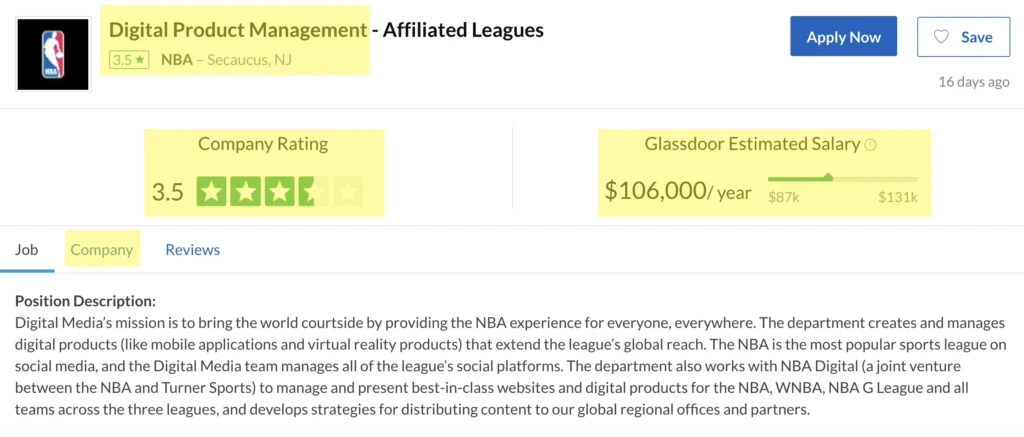
Image Source: nycdatascience
Most people think of Glassdoor.com as a place for reading reviews or checking salaries before a job interview. That’s fine, but companies looking for an edge are going deeper. They’re pulling structured data from Glassdoor at scale to spot trends, benchmark against rivals, and uncover insights that go way beyond a single review.
So what kind of data are we talking about when we say scraping Glassdoor?
Employee Reviews
Let’s start with the obvious one, reviews. When you read one or two, you get personal stories. But when you collect hundreds or thousands, you start to see patterns. What do employees consistently complain about? What do they praise? Is that shifting over time?
For example, if reviews for a competitor keep mentioning “burnout” or “poor communication,” that tells you something. It might be an opportunity to attract talent who are ready to leave, or a sign that leadership there is struggling. Either way, it’s the kind of real-world data you won’t find in press releases or financial reports.
Salary and Compensation
Glassdoor has tons of self-reported salary data, broken down by role, location, and experience level. And yes, it’s not always perfect. But when you scrape this data in bulk, it starts to average out and becomes pretty useful.
If you’re a company trying to stay competitive in hiring, scraping this info can tell you how your pay stacks up. Are you underpaying compared to similar companies? Are salaries rising faster in certain locations? This kind of insight can help you avoid losing candidates, or worse, your own employees.
Job Postings
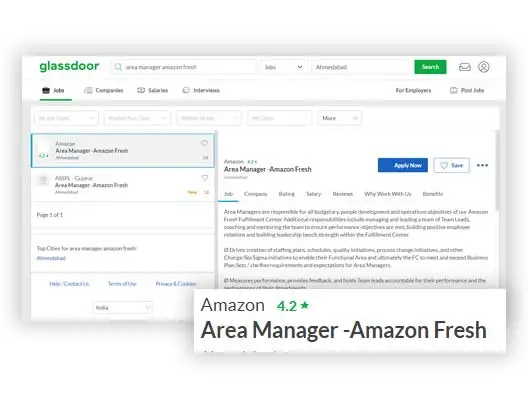
Image Source: 3i data scraping
One of the most underrated things on Glassdoor? The job listings. By tracking which roles a competitor is hiring for, and how those change over time, you can often guess what’s coming before it happens.
Say a logistics company suddenly starts posting a bunch of openings for data analysts or AI engineers. That’s a strong clue they’re investing in automation or predictive analytics. You don’t need a press announcement to figure that out, just a scraping tool and a few weeks of tracking.
Interview Questions
It might sound small, but interview reviews often include the actual questions candidates were asked, and how the process was structured. If you’re trying to hire from the same talent pool, this is like getting your hands on your rival’s playbook.
Companies use this kind of data to prep their recruiters, fine-tune their own hiring processes, or help candidates get an edge when they’re targeting a specific employer.
Benefits and Perks
Job seekers care about more than just money now. Remote work, mental health days, flexible hours, all of this is showing up in company profiles and job posts on Glassdoor.
By scraping and analyzing this kind of data, companies can see what’s becoming the new standard and where they might be falling behind. It’s also a way to spot shifts in how employers are trying to position themselves in the job market.
There’s a lot more on Glassdoor.com than most people realize. And when you use web scraping Glassdoor data the right way, you start to see the big picture, about your competitors, your market, and even your own company.
How Companies Use Scraping Glassdoor Data for Competitive Advantage
Now that we know what kind of data lives on Glassdoor.com, let’s talk about what companies actually do with it. When scraped and analyzed correctly, this information can help shape everything from hiring strategy to market positioning.
Here’s how forward-thinking businesses are using scraping Glassdoor as part of their competitive playbook:

1. Benchmarking Compensation and Benefits
Salary transparency is growing, but traditional salary surveys can be slow and expensive. With Glassdoor scraping, companies can collect real-time compensation data across roles, industries, and geographies. This helps HR teams ensure their offers are competitive, especially in industries where skilled workers get multiple offers at once.
More importantly, organizations can spot trends in benefits, too. If competitors start offering four-day workweeks or hybrid models as a standard perk, scraping this data early gives you a chance to adapt before you start losing talent.
2. Monitoring Employer Brand Perception
Reputation isn’t just about customers anymore, it’s also about how current and former employees feel. That’s why more companies are investing in web scraping Glassdoor reviews to track changes in brand sentiment over time.
Are former employees mentioning “lack of growth opportunities” more often than they used to? Are recent reviews more positive or more negative? Using sentiment analysis tools on review data can help talent teams understand if internal initiatives are paying off, or if deeper cultural changes are needed.
It also helps with competitor analysis. If a rival’s reviews start trending negative, that’s a signal you might be able to poach disillusioned employees with the right outreach and messaging.
3. Tracking Competitor Hiring Activity
Talent intelligence teams regularly use Glassdoor API scraping services (or custom web scrapers) to monitor hiring patterns at competitor companies. By tracking job postings, they can predict moves long before they happen.
For example, if a logistics startup suddenly starts hiring dozens of supply chain analysts across a new region, it might be preparing for an expansion. That information can influence your own investment decisions or sales targeting.
This kind of scraping Glassdoor jobs data also reveals the types of skills and technologies competitors are investing in, whether it’s cloud infrastructure, AI, or cybersecurity, helping you plan your own training and hiring strategies.
4. Identifying Internal Risk Factors
Some companies even use Glassdoor data to look inward. If your own reviews reveal recurring negative themes, like poor leadership or lack of diversity, it can serve as an early warning system for turnover or disengagement.
This makes Glassdoor a kind of pulse-check tool. Instead of relying only on internal surveys (which employees may not always fill out honestly), external feedback can confirm what’s really going on inside your company.
5. Supporting M&A and Investment Research
When private equity firms, VCs, or corporate strategy teams look at acquisition targets, they often scrape Glassdoor as part of their due diligence. Cultural issues, high turnover, or toxic leadership often show up in reviews long before they appear in financial statements.
In this way, web scraping Glassdoor becomes part of the risk management toolkit, not just for HR, but for investors and strategic decision-makers.
Whether it’s spotting a competitor’s next move or fixing your own internal problems, scraping Glassdoor data provides real-world, real-time insight that’s hard to find anywhere else.
How Companies Set Up Tools for Web Scraping Glassdoor at Scale
So you’re convinced that scraping Glassdoor can offer a real competitive edge—but how do companies actually get it done? This isn’t just about firing up a basic scraper and hoping for the best. At scale, you need structure, smart tooling, and a clear plan for turning raw data into useful insights.
Let’s walk through how businesses are setting up their Glassdoor scraping systems in the real world.
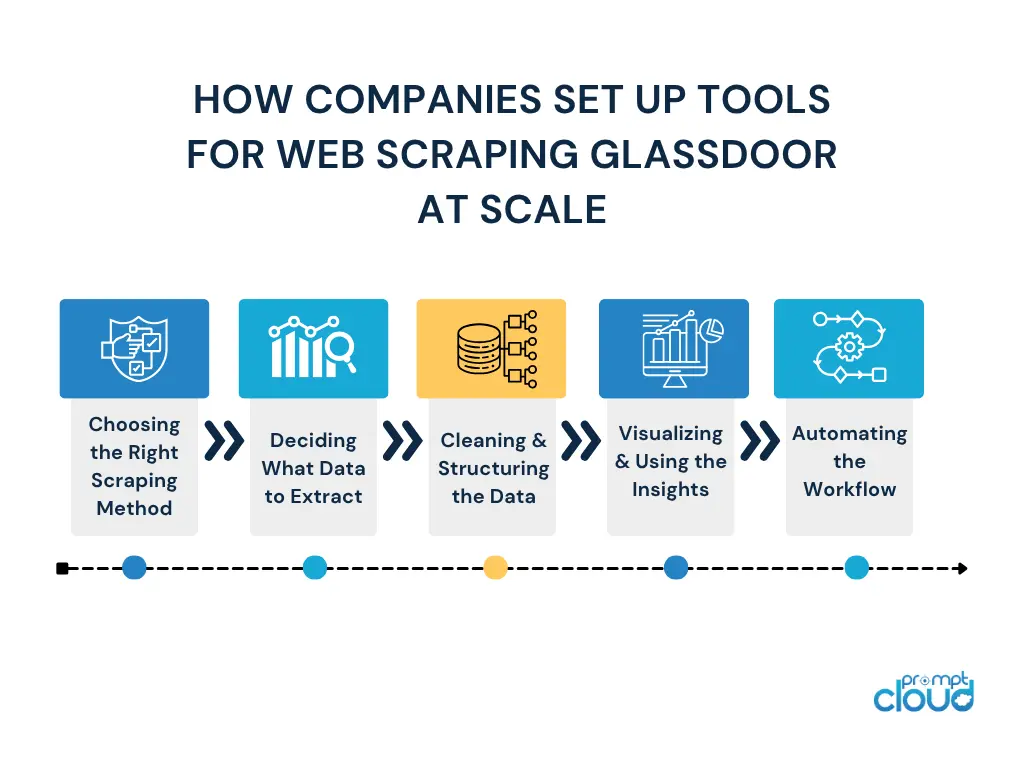
Step 1: Choosing the Right Scraping Method
There are a few ways companies go about web scraping Glassdoor. The most common approaches include:
- Custom-built scrapers using Python – These are great for tech-savvy teams. Libraries like BeautifulSoup, Scrapy, or Selenium are often used to extract and parse data. Developers set up scripts to regularly crawl specific sections like reviews, jobs, or salaries.
- Third-party scraping services – Not every company wants to manage infrastructure or deal with anti-scraping defenses. That’s where professional Glassdoor scraping services come in. These services offer scalable, pre-built tools that handle the heavy lifting, often with added features like data normalization or enrichment.
- APIs (when available) – Glassdoor’s official API has limited access and is generally restricted to approved partners. But when available, it’s a cleaner and safer way to access structured data without worrying about scraping bans.
Each option comes with trade-offs. Custom tools offer control and flexibility but require ongoing maintenance. Third-party services save time and reduce legal exposure but come at a higher cost. The key is to match your approach to your goals and technical capabilities.
Step 2: Deciding What Data to Extract
We’ve already talked about the value of employee reviews, salaries, jobs, and interview data. But scraping everything at once isn’t always practical or necessary. Smart companies usually focus on one or two areas first.
For instance, an HR analytics team might start with web scraping Glassdoor reviews to run sentiment analysis. A competitive intelligence team, on the other hand, might prioritize job listings to monitor hiring trends across rivals.
The important thing is to keep your scraping targeted. Pulling thousands of reviews or jobs is only useful if you know what questions you’re trying to answer with that data.
Step 3: Cleaning and Structuring the Data
Raw data from scraping is messy. You might end up with duplicates, weird formatting, or missing values. This is where the real work begins—turning unstructured data into something you can actually analyze.
Companies usually apply scripts or use data platforms like Snowflake or BigQuery to clean and organize the data. Review dates, star ratings, job titles, salary ranges—they all get turned into structured fields so that teams can slice, filter, and visualize trends over time.
Many also apply natural language processing (NLP) to extract themes from reviews, like recurring mentions of “burnout,” “diversity,” or “career growth.” This kind of automated tagging helps make sense of large review volumes fast.
Step 4: Visualizing and Using the Insights
Once the data is clean, it’s time to actually put it to work. Many companies plug their Glassdoor scraping output into dashboards using tools like Tableau, Power BI, or even custom-built interfaces.
From there, business leaders can track KPIs like:
- Employer sentiment score over time
- Salary competitiveness by region
- Top-mentioned strengths and weaknesses by former employees
- Competitor hiring surges or slowdowns
This visibility helps teams across the org—from HR to strategy to investor relations—make sharper decisions.
Step 5: Automating the Workflow
The last piece of the puzzle is automation. Once companies see the value of scraping Glassdoor at scale, they rarely stop at a one-time pull.
They build automated systems that check for updates weekly or even daily, pull new data, clean it, and refresh the dashboards, all without manual intervention. That way, they’re always working with the latest insights instead of month-old snapshots.
The Risks of Getting It Wrong: Pitfalls to Avoid When Scraping Glassdoor
Scraping Glassdoor can unlock serious insight—but only if it’s done right. There’s a fine line between smart data collection and careless scraping that backfires. Companies that dive in without a clear plan can end up with messy data, legal headaches, or worse—bad decisions based on faulty signals.
Let’s walk through a few common pitfalls businesses should watch out for.
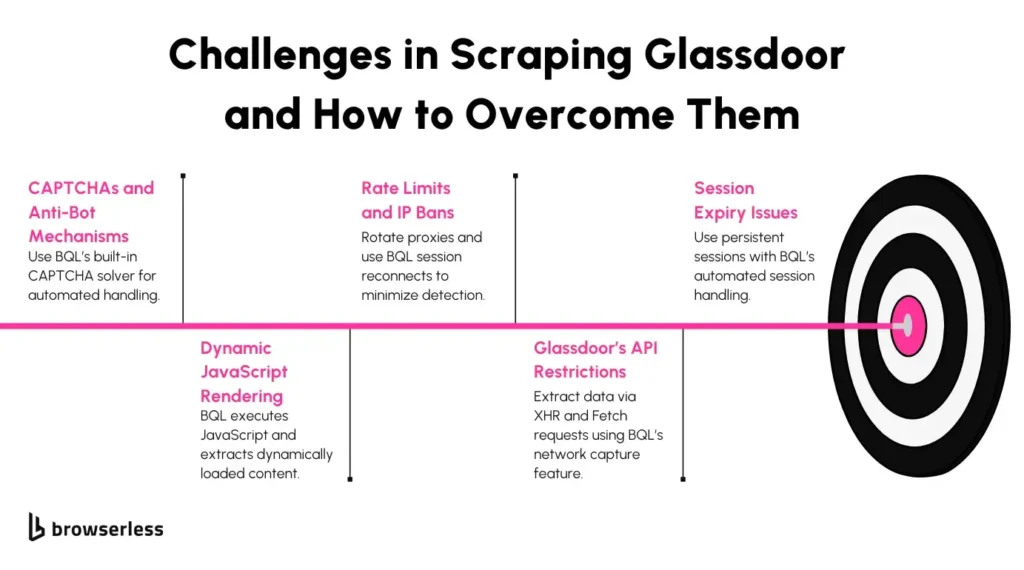
Image Source: browserless
1. Ignoring Terms of Service
It’s tempting to spin up a scraper and pull everything in sight. But remember: Glassdoor.com has terms of use, and aggressive scraping can get your IP blocked—or worse, trigger legal trouble. Not everything on the site is public in the legal sense. Reviews that require a login or aren’t indexed by search engines are generally considered protected.
If you’re planning to scrape, especially at scale, use tools or services that understand the legal boundaries. Some companies opt for Glassdoor API scraping services or ethical web scraping platforms that stay within compliance while still collecting valuable data.
2. Collecting More Than You Can Handle
Another common mistake? Grabbing way more data than you can realistically process. Just because you can scrape thousands of reviews doesn’t mean you should, especially if you don’t have a plan to clean, tag, and analyze them.
Too much unstructured data becomes noise fast. A focused approach—like targeting reviews by job function, location, or date range—can produce cleaner insights and save your team hours of sorting through irrelevant info.
3. Forgetting Context
Data scraped from Glassdoor tells a story, but it’s only part of the picture. Reviews are subjective. Salaries are self-reported. Job posts don’t always reflect real-time hiring. If you treat the data like absolute truth, you risk drawing the wrong conclusions.
The best companies don’t take the data at face value. They combine Glassdoor scraping with other signals, like LinkedIn activity, internal attrition rates, and market trends, to build a fuller picture before making big decisions.
4. Overlooking Bias in Reviews
Employee reviews skew toward the extremes, people often post when they’re either very happy or very frustrated. If you’re not accounting for that bias, your sentiment analysis may miss the middle ground entirely.
This is where machine learning and natural language processing (NLP) help. By looking for patterns over time and across a broad sample, you can reduce the impact of emotional outliers and get to the real signals hiding in the noise.
5. Not Having a Long-Term Plan
Scraping Glassdoor.com shouldn’t be a one-off project. The real value shows up when you’re tracking changes over time, like how sentiment shifts after a merger, or how job postings evolve quarter to quarter.
Without automation, though, that kind of tracking becomes a burden. That’s why many companies eventually move from manual scraping to fully automated pipelines that collect, clean, and update the data regularly.
Why Glassdoor Scraping Is Becoming a Must-Have in Data-Driven Strategy
In a world where talent is one of the most competitive assets a business can have, relying on outdated or incomplete data just doesn’t cut it anymore. That’s why scraping Glassdoor has gone from a niche tactic to a mainstream strategy across industries.
Smart companies now treat platforms like Glassdoor.com not just as review sites, but as dynamic, real-time intelligence sources. Whether you’re a fast-scaling startup or a global enterprise, the ability to extract and act on signals from employee feedback, salary trends, and hiring patterns gives you a real edge.
And this isn’t just theory. Businesses that embed web scraping Glassdoor data into their decision-making tend to:
- Hire faster and more competitively
- Respond to cultural issues before they escalate
- Stay ahead of market shifts and competitor moves
- Create more authentic employer brands that resonate with candidates
That kind of insight used to require expensive consultants or lagging industry reports. Now, with the right tools and ethical practices, it’s available straight from the public web—and it updates itself in real time.
Of course, none of this works without intent and structure. Scraping data is just the first step. The companies that get real value are the ones that treat it as a long-term asset—cleaning it, contextualizing it, and putting it in the hands of the teams that need it most.
At PromptCloud, we help businesses ethically and efficiently scrape large-scale review, job, and salary data from platforms like Glassdoor.com. If you’re looking for custom, compliant, and high-quality web scraping solutions, reach out to us and let’s build your data edge.









![Export Website To CSV A Practical Guide for Developers and Data Teams [2025 Edition]](https://www.promptcloud.com/wp-content/uploads/2025/10/Export-Website-To-CSV-A-Practical-Guide-for-Developers-and-Data-Teams-2025-Edition-100x80.webp)
